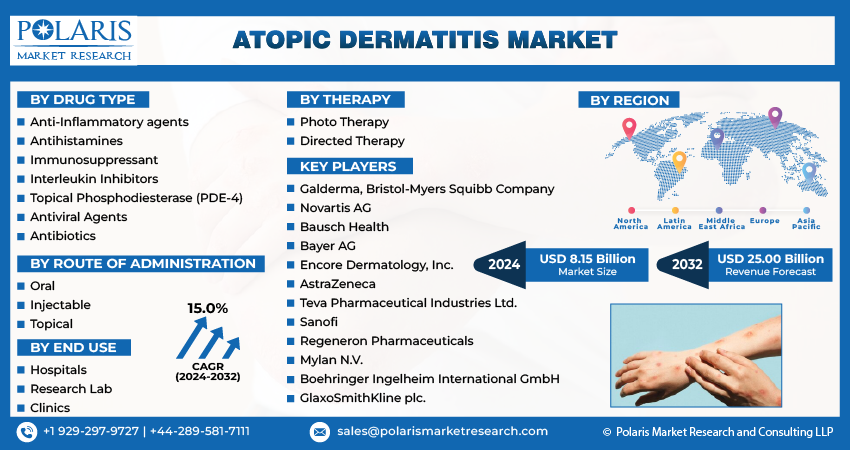The atopic dermatitis market size is expected to reach USD 25.00 billion by 2032,expected to grow at a CAGR of 15.0% during the forecast period.
The Atopic Dermatitis (AD) Market focuses on therapies designed to manage and treat atopic dermatitis, a chronic inflammatory skin condition characterized by intense itching, redness, and eczema. AD affects millions worldwide, impacting quality of life and increasing healthcare burdens. The market has witnessed significant growth in recent years, driven by advancements in biologic therapies, growing awareness, and increased diagnosis rates.
Market Growth Drivers
- Rising Prevalence of Atopic Dermatitis
- AD affects approximately 10–20% of children and 1–3% of adults globally. Urbanization and lifestyle changes are contributing to its rising prevalence.
- Advancements in Biologic Therapies
- Introduction of targeted biologics such as dupilumab and JAK inhibitors has revolutionized AD treatment, offering better symptom management for moderate-to-severe cases.
- Increased Awareness and Diagnosis Rates
- Campaigns by healthcare organizations have improved public awareness of AD, leading to higher diagnosis and treatment adoption.
Some of the major players operating in the global market include:
- Galderma
- Bristol-Myers Squibb Company
- Novartis AG
- Bausch Health
- Bayer AG
- Encore Dermatology
- Inc.
- AstraZeneca
- Teva Pharmaceutical Industries Ltd.
- Sanofi
- Regeneron Pharmaceuticals
- Mylan N.V.
- Boehringer Ingelheim International GmbH
- GlaxoSmithKline plc
Download Free Sample PDF Copy of the Report:
Key Trends in the Atopic Dermatitis Market
- Emergence of JAK Inhibitors
- Janus kinase (JAK) inhibitors, such as abrocitinib and upadacitinib, are gaining traction for their efficacy in reducing inflammation and itch in moderate-to-severe AD cases.
- Focus on Personalized Medicine
- Advances in genetic and biomarker research are enabling tailored therapies, improving treatment outcomes for individual patients.
- Topical Formulation Innovations
- Development of non-steroidal topical therapies, such as crisaborole and ruxolitinib cream, provides new options for patients with mild-to-moderate AD.
Recent Developments
- In June 2022, Sanofi’s Dupixent (dupilumab) was given the go-ahead by the US Food and Drug Administration (FDA) for treating children with moderate-to-severe atopic dermatitis aged six months to 5 years when topical prescription treatments are ineffective or inappropriate.
- In January 2022, The US FDA authorized Pfizer’s CIBINQO (abrocitinib) for treating people with moderate to severe atopic dermatitis. Janus kinase 1 (JAK1) inhibitors are present in the oral medication CIBINQO (abrocitinib).
𝐒𝐞𝐠𝐦𝐞𝐧𝐭𝐚𝐥 𝐀𝐧𝐚𝐥𝐲𝐬𝐢𝐬:
The research study includes segmental analysis that divides the market into distinct groups or segments based on common characteristics. With market segmentation, businesses can identify specific customer groups that are more likely to be interested in specific products or services. Also, it enables these businesses to focus their marketing efforts and resources more efficiently, leading to higher conversion rates and improved return on investment. Furthermore, segmentation analysis helps companies develop personalized products or services, which can result in increased customer loyalty and improved customer satisfaction.
Atopic Dermatitis, by Drug Type Outlook (Revenue – USD Billion, 2019-2032)
- Anti-Inflammatory agents
- Antihistamines
- Immunosuppressant
- Interleukin Inhibitors
- Topical Phosphodiesterase (PDE-4)
- Antiviral Agents
- Antibiotics
Atopic Dermatitis, by Route of Administration Outlook (Revenue – USD Billion, 2019-2032)
- Oral
- Injectable
- Topical
Atopic Dermatitis, by Therapy Outlook (Revenue – USD Billion, 2019-2032)
- Photo Therapy
- Directed Therapy
Atopic Dermatitis, by End Use Outlook (Revenue – USD Billion, 2019-2032)
- Hospitals
- Research Lab
- Clinics
The Atopic Dermatitis Market is poised for significant growth, driven by advancements in biologics, the introduction of JAK inhibitors, and increasing global awareness. While challenges such as high costs and treatment side effects remain, ongoing research and innovation are expected to address these barriers. The market offers substantial opportunities for pharmaceutical companies, with a focus on developing cost-effective, patient-centric solutions.

